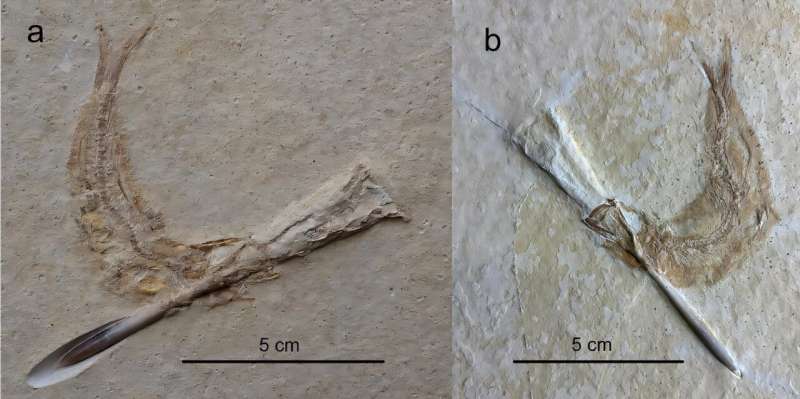
In a remarkable discovery, a study led by Dr. Martin Ebert and Dr. Martina Kölbl-Ebert has unveiled that some Jurassic fish, specifically the extinct genus Tharsis, choked to death on squid-like cephalopods known as belemnites. This research, published in the journal Scientific Reports, sheds new light on the life and challenges faced by marine organisms during the Late Jurassic period.
The study examined approximately 4,200 Tharsis fossil specimens from the Solenhofen Plattenkalk, a well-known marine fossil deposit. It was found that some of these subadult fish attempted to swallow belemnites, leading to fatal consequences. The Solenhofen Limestone is renowned for its exceptional preservation of fossils, including famous finds like the Archaeopteryx.
The Solnhofen Archipelago: A Fossil Treasure Trove
The Eichstätt-Solnhofen basins, part of the Solnhofen Archipelago, were characterized by high salinity and low oxygen levels during the Late Jurassic. These harsh conditions made the lagoon floors inhospitable to life, yet they provided an ideal environment for the preservation of fossils. Among these, Tharsis is the second most common genus, with thousands of specimens cataloged by researchers.
In contrast, belemnites are a rarer find in the Plattenkalk basin, with only about 120 specimens discovered compared to the 15,000 fish fossils. Belemnites, which thrived in open seas, were among the first to vanish in low-oxygen environments. Many of the fossilized belemnites found were overgrown with bivalves, suggesting they had been floating dead on the water’s surface before sinking to the bottom.
Unraveling the Mystery of Tharsis and Belemnites
During their examination, Dr. Ebert and Dr. Kölbl-Ebert discovered that some Tharsis fossils had belemnites lodged in their throats. This phenomenon had not been documented before, possibly due to the sheer volume of Tharsis fossils, which often leads researchers to focus only on exceptionally preserved specimens.
Dr. Kölbl-Ebert explained,
“Since Tharsis is so very common, taxonomists usually look only at a very few, exceptionally well-preserved specimens. Martin looks at so many specimens because he is also doing statistics and is interested in ecology as well.”
Why Did Tharsis Swallow Belemnites?
Tharsis were micro-carnivores or visual zooplanktivores, likely in the habit of feeding on remnants of decaying tissue, algae, or bacterial growth from floating objects. The researchers hypothesize that the belemnites, already dead and possibly overgrown with algae, might have been mistaken for food.
Dr. Kölbl-Ebert noted,
“We assume from present-day experience that such floating objects are quickly overgrown with algae and bacteria, thus for the fish they smell and taste like food.”
Implications and Future Research
The study provides a unique glimpse into the ecological interactions of the Jurassic period, highlighting the dangers faced by marine life. The findings also underscore the importance of examining a wide range of fossil specimens to uncover previously overlooked phenomena.
As researchers continue to explore the Solnhofen deposits, these insights may lead to a deeper understanding of the evolutionary pressures and environmental challenges that shaped ancient marine ecosystems. Future studies could further investigate the ecological roles of other marine organisms in the Solnhofen Archipelago and their interactions with the environment.
This research not only enriches our understanding of the past but also serves as a reminder of the complex and often perilous interactions that have always existed in nature.







